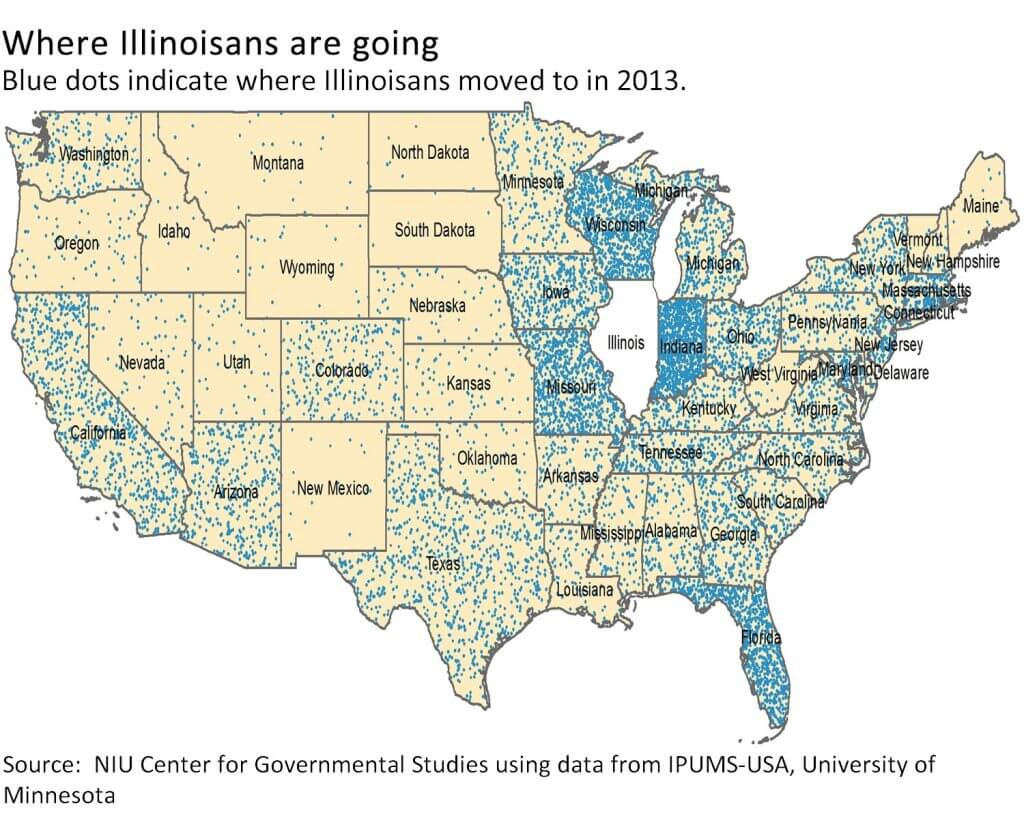New U.S. Census Bureau data shows Illinois had nearly 10,000 fewer residents in 2014 than in the previous year – the largest numerical decline of any state in the nation and the first statewide population dip since the mid-1980s.
Sherrie Taylor, a researcher at Northern Illinois University’s Center for Governmental Studies (CGS), said six states lost population from 2013-2014: Illinois, West Virginia, Connecticut, New Mexico, Alaska and Vermont.
Of those, Illinois easily had the largest numerical population decline – 9,972 people – followed by West Virginia with a loss of 3,269 residents.
CGS receives embargoed U.S. Census Bureau reports several times each year as one of three coordinating agencies of the State Data Center Network. While the latest report focused on counties, NIU researchers are able to extrapolate that data to draw statewide, regional and even national conclusions.
Overall, the U.S. population grew by less than 1 percent. Texas, California and Florida saw the largest gains nationwide.
Taylor said past trends indicate most of those leaving the Land of Lincoln are not seeking warmer climates but rather moving to neighboring states.
 While information on specific migration patterns for 2014 is not yet available, data from the years 2010 through 2013 showed Indiana, Wisconsin and Missouri picked up the largest numbers of former Illinoisans. Collectively, nearly 300,000 Illinoisans moved to those states during that four-year period, but during that time, Illinois also picked up enough in-migration population to counterbalance the loss.
While information on specific migration patterns for 2014 is not yet available, data from the years 2010 through 2013 showed Indiana, Wisconsin and Missouri picked up the largest numbers of former Illinoisans. Collectively, nearly 300,000 Illinoisans moved to those states during that four-year period, but during that time, Illinois also picked up enough in-migration population to counterbalance the loss.
 “There are many factors at work here, and census information only tells us so much,” Taylor said. “But we do know that most of those who left in recent years took jobs in those other states, so that suggests economic factors – either better opportunities or perhaps concerns about Illinois’ delicate financial health.”
“There are many factors at work here, and census information only tells us so much,” Taylor said. “But we do know that most of those who left in recent years took jobs in those other states, so that suggests economic factors – either better opportunities or perhaps concerns about Illinois’ delicate financial health.”
Taylor said declining birth rates and an aging population also contributed to Illinois’ net population loss from 2013 to 2014.
Overall, only 17 out of 102 counties in Illinois experienced population growth last year.
Kendall County saw growth of 1.5 percent, or an additional 1,825 people. That was the highest percentage increase last year for any Illinois county. Kane County saw growth of 0.6 percent, or an additional 3,029 people—the largest numeric increase for an Illinois county.
Cook and McHenry counties experienced negligible losses in population. Projections by the Illinois Department of Public Health anticipate Cook County to decline in population through 2025, while population is projected to increase in the collar counties.
Will County, which was experiencing rapid growth prior to the 2008 recession, said goodbye to more residents than it welcomed in 2014. Overall, the county’s population dropped by 2,866 residents.
Locally, DeKalb County saw a small increase of 660 residents – a bump so small that it puts the county in the “no significant change” category. Unlike most of the state, DeKalb County saw nearly twice as many births as deaths, and experienced in-migration of 212 international residents.
Media contacts: Joe King or Tom Parisi, NIU Media and Public Relations

